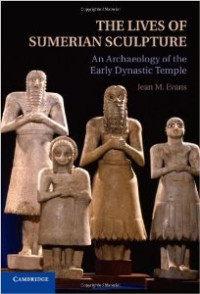Text
The Lives of Sumerian Sculpture; An Archaelogy of the Early Dynastic Temple
Buku ini membahas patung dibuat selama periode Dinasti Awal (2900-2350 SM) Sumeria, sebuah wilayah yang sesuai dengan masa kini Irak selatan. Fitur hampir secara eksklusif di kompleks candi, sekitar 550 patung batu Dinasti Awal dari sosok manusia yang diukir dalam gaya abstrak selamat. Mencatat sejarah intelektual dari sejarah seni Timur Dekat kuno dan arkeologi di persimpangan patung dan estetika, buku ini berpendapat bahwa awal penerimaan modern Sumer masih mempengaruhi ide-ide tentang patung ini. Melibatkan juga dengan arkeologi candi Dinasti Awal, buku akhirnya menganggap apa patung batu dari sosok manusia telah ditandai, baik di zaman modern dan kuno. menempatkan pembaca dalam dunia penelitian akhir abad ke-19 di taxonomics manusia dan ras, jelas mengutip bagaimana teori quasiscientific tentang asal-usul peradaban dan "Sumeria Masalah" dipengaruhi persepsi barat Sumer. Hubungan antara arkeolog awal Mesopotamia dan pengenaan mereka analisis yang salah dari sisa-sisa kerangka disajikan sebagai contoh bagaimana awal "data" telah mewarnai interpretasi kami saat ini budaya material Mesopotamia.
This book examines the sculptures created during the Early Dynastic period (2900-2350 BC) of Sumer, a region corresponding to present-day southern Iraq. Featured almost exclusively in temple complexes, some 550 Early Dynastic stone statues of human figures carved in an abstract style have survived. Chronicling the intellectual history of ancient Near Eastern art history and archaeology at the intersection of sculpture and aesthetics, this book argues that the early modern reception of Sumer still influences ideas about these sculptures. Engaging also with the archaeology of the Early Dynastic temple, the book ultimately considers what a stone statue of a human figure has signified, both in modern times and in antiquity. places the reader in the world of late 19th-century studies in human taxonomics and race, clearly citing how quasiscientific theories about the origins of civilization and the "Sumerian Problem" influenced western perceptions of Sumer. The relationships between early archaeologists in Mesopotamia and their imposition of incorrect analyses of skeletal remains is presented as an example of how early "data" has colored our current interpretations of Mesopotamian material culture
Ketersediaan
Informasi Detail
- Judul Seri
-
-
- No. Panggil
-
732.5 Eva l
- Penerbit
- New York : Cambridge University Press., 2012
- Deskripsi Fisik
-
xi+273 hal.; 23 cm
- Bahasa
-
English
- ISBN/ISSN
-
978-1-107-01739-9
- Klasifikasi
-
732.5
- Tipe Isi
-
-
- Tipe Media
-
-
- Tipe Pembawa
-
-
- Edisi
-
-
- Subjek
- Info Detail Spesifik
-
-
- Pernyataan Tanggungjawab
-
-
Versi lain/terkait
Tidak tersedia versi lain
Lampiran Berkas
Komentar
Anda harus masuk sebelum memberikan komentar

 Karya Umum
Karya Umum  Filsafat
Filsafat  Agama
Agama  Ilmu-ilmu Sosial
Ilmu-ilmu Sosial  Bahasa
Bahasa  Ilmu-ilmu Murni
Ilmu-ilmu Murni  Ilmu-ilmu Terapan
Ilmu-ilmu Terapan  Kesenian, Hiburan, dan Olahraga
Kesenian, Hiburan, dan Olahraga  Kesusastraan
Kesusastraan  Geografi dan Sejarah
Geografi dan Sejarah